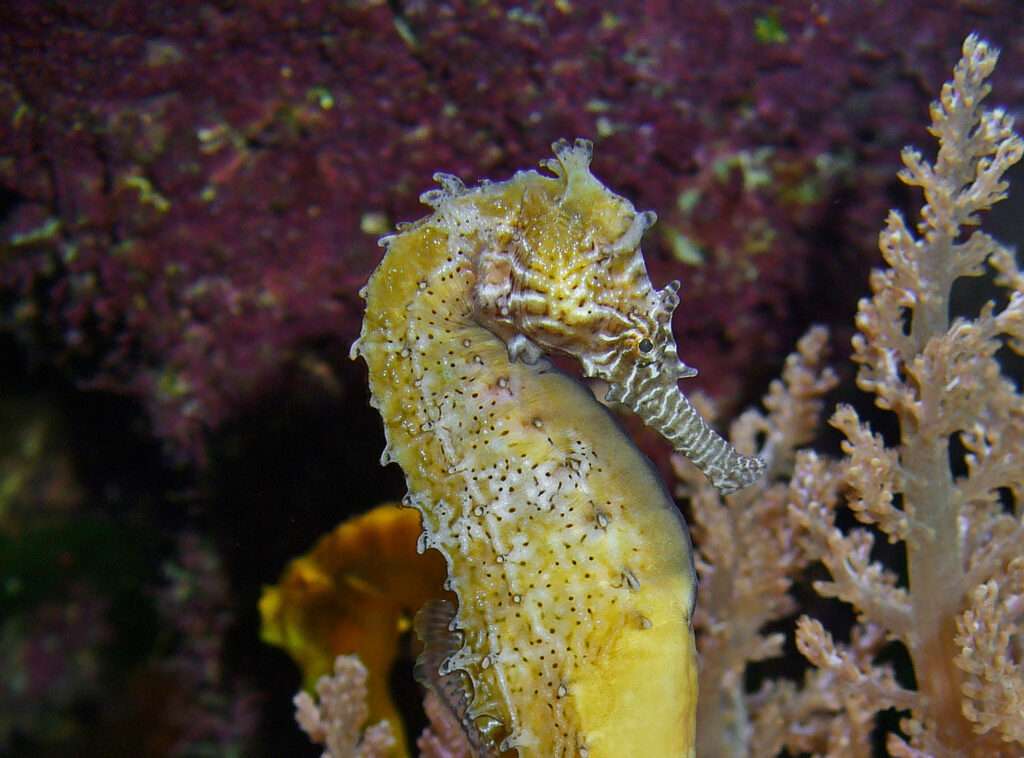
The Hippocampus barbouri, or Barbour’s Seahorse, has an eye-catching yellow color at birth with a distinctive zebra striped nose. It is a unique species because of the texture of its skin and the spines that protrude from its body. It likes to stay around in intertidal areas near seagrass beds and mangrove roots, like the majority of seahorses do. The Philippines, Indonesia, and Malaysia all have coastlines that are home to this seahorse, which is native to the Indo-Pacific. The Barbour’s seahorse is naturally yellow and only alters hues between pale yellow and yellowish brown. The majority of seahorses adapt to their surroundings and change color depending on their mood.
The temperature of a reef tank can be used to maintain Barbour’s seahorses because they naturally occur in shallow water. It might have a few corals, especially soft corals, but I wouldn’t put stinging or current-dependent corals in there. A 20 to 30 gallon aquarium is the ideal size for a pair of Barbour’s seahorses. Cover all pump intakes completely to prevent the possibility of their being trapped and unable to escape. The best tank mates for seahorses are other members of their own species, although they can also live with pipefish, gobies, dartfish, blennies, and other seahorses. Typically, crustaceans don’t bother seahorses, however Barbour’s seahorses occasionally try to consume tiny shrimp or hermit crabs.
Habitat
The sole species of seahorse found exclusively in Southeast Asia is Hippocampus barbouri. It has been established that they are present in the Philippines, Malaysia, and Indonesia. The shallow water species Hippocampus barbouri lives in muddy places, mangrove swamps, estuaries, and seagrass beds that are less than 10 meters deep. They can be found in a variety of environments in protected bays and along beaches. This seahorse frequently coexists with calcareous algae.

Physical Appearance
The acute eye and nose spine, as well as the double cheek spine, are among the highly-developed spines of the hippocampus barbouri. The first dorsal spine of these animals is the longest, broadest, and somewhat bent rearward. The tail is relatively short in comparison to the body and has a succession of long and short spines. The coronet, or crown, is somewhat high and has four or five spines. The nose is thin and striped. The eye has fine lines that extend outward. Hippocampus barbouri can be white, yellow, greenish grey, or light brown in colour, and its body may have reddish brown lines or patches. This species exhibits sexual dimorphism, with males having a brood pouch that females do lack. The average height of a male is between 11 and 15 cm, whilst the average height of a girl is between 11 and 13 cm. Around 15 cm is the H. barbouri’s maximum height.
Food Habits
Although little is known about the Hippocampus barbouri’s food in the environment, their sedentary lifestyle probably limits them to phytoplankton and zooplankton, which they consume via the snout.
Reproduction
Hippocampus barbouri, like many seahorses, is monogamous and mates several times during a breeding season, occasionally with the same partner across several breeding seasons. The male’s brood pouch, which is divided from the body cavity by a cartilage wall, is where females lay their eggs. Male seahorses carry eggs during development like other seahorses and control them using a modified anal fin. Daily greetings between males and females during pregnancy help to enhance pair ties.
Table





